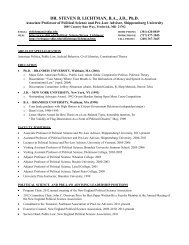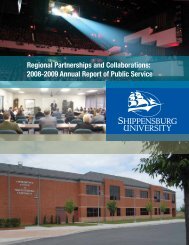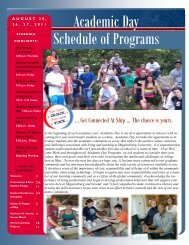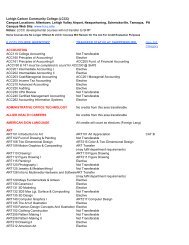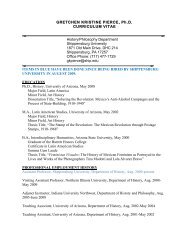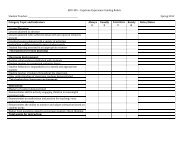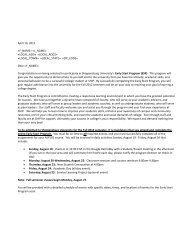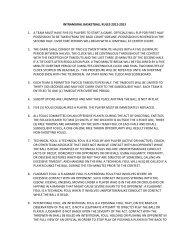Complete Issue - Shippensburg University
Complete Issue - Shippensburg University
Complete Issue - Shippensburg University
- No tags were found...
You also want an ePaper? Increase the reach of your titles
YUMPU automatically turns print PDFs into web optimized ePapers that Google loves.
Rolston St. Hilaire: The Residential Urban Landscape as a frontier for water conservation 15is highest and human contact is perceived to be low(Devitt et al. 2004). While irrigating the residentialurban landscape with reuse water is a perfect way toextend existing water supplies, greater managementskills are needed to minimize soil salinization, plantdamage, health-related problems, and loss in aestheticappearance of water features (St. Hilaire et al. 2008).Travails are likely to occur at a frontier andwater conservation in the residential landscape is noexception. A substantial body of scientific knowledgeon the most effective ways to conserve water in theurban landscape is lacking. So, it is hard to predictthe outcome of those travails. For example, in 1981,a court ordered the Denver Water Department topromote water conservation in outdoor landscapes.This action led to the development of xeriscapes aswater conserving landscapes (Hagan 1988). In contrast,on September 17, 2007, a severe drought promptedthe state of Georgia to ban outdoor watering (Brownand Pharr 2007). This decision had a financial impactof $3.5 billion on Georgia’s urban agriculture sector.These two historical events are likely to be repeated insome way. The urban sector could be the maelstromfor water conservation efforts as more water isdiverted from agricultural to residential use and moreconstituents converge toward an increasingly scarceresource.More research on effective water conservationmeasures for the residential landscape wouldensure sustainable water conservation methods aredeveloped. There should be greater public investmentin this area of research. Possible research areasinclude understanding the relationships betweenresidential landscape types and the potential for waterconservation. Ways to divert excess precipitationinto the residential landscape must be perfected.One economic incentive program, often called Cashfor Grass, offered rebates for conversion of turf toxeriscapes. An economic analysis of this program,led Addink (2008) to conclude that Cash for Grassprograms are an expensive way to save water. So, aresearch question that needs to be answered for everyproposed economic incentive is whether this incentiveis cost effective in promoting water conservation in theurban landscape. Finally, the block rate pricing modelthat many municipalities used to price water may notbe fully capturing the real price of water (Dalhuisen etal. 2003). For that reason, newer water pricing models,such as the Irvine Ranch Water District’s (IRWD)tiered-rate structure that reflect a water budget,should be developed and tested. The IRWD waterpricing model decreased water consumption withoutjeopardizing the urban landscape function (IrvineRanch Water District 2008b).Population growth, increased economic activity, andurbanization will increase the demand for water in theUnited States. In fact, the demand for water is alreadyexceeding the supply (Dickinson 2008), so conservationof the existing water supply is quintessential for boththe United States and urban areas. The lack of waterhas the potential to jeopardize our food supply, disruptfragile ecosystems, alter alliances among constituents,and threaten our way of life. The heterogeneity of theurban landscape and the plethora of existing urbanwater conservation strategies have limited a cohesivestrategy for urban water conservation. Sensible waterconservation standards, such as national standards forplumbing fixtures have contributed to improvement inefficiency of use of the in-house water supply. Perhapsthe same could be considered for the urban landscape.This could be one step that could be used to secure ourfuture water supplies.ReferencesAddink, S. 2008. “Cash for grass” –A cost effective method toconserve landscape water? 11 Feb. 2008, http://ucrturf.ucr.edu/topics/Cash-for-Grass.pdf.Brown, L.T and K.R. Pharr. 2007. Forum: <strong>University</strong> activelylooking for additional ways to conserve water, AthensBanner-Herald, Oct. 25, 2007. 10 Nov. 2007, http://www.onlineathens.com/stories/102507/opinion_20071025037.shtml.California Office of Water Use Efficiency. 2006. Landscapewater use program. Sacramento: California Department ofWater Resources. 15 Apr. 2006, http://www.owue.water.ca.gov/landscape/index.cfm.Dalhuisen, J.M., R.J.G.M. Florax, H.L.F. de Groot, and P. Nijkamp.2003. Price and income elasticities of residential waterdemand: a meta-analysis. Land Economics 79: 292-308.Davis, S., M.D. Dukes, S.Vyapari, and G.L. Miller. 2007.Evaluation and demonstration of evaporation-based irrigationcontrollers. Proc. ASCE EWRI World Environmental andWater Resources Congress, May 15-19, 2007, Tampa, Fla.Devitt D.A., R.L. Morris, D. Kopec, and M. Henry. 2004. Golfcourse superintendents attitudes and perceptions towardusing reuse water for irrigation in the southwestern UnitedStates. HortTechnology 14:1-7.Dickinson, M. 2008. Water conservation in the United States: adecade of progress. 10 Jan. 2008, http://wwa.colorado.edu/resources/water_demand_and_conservation/US_WaterConservationProgress_Dickinson.pdf.Emrath, P. 2000. Residential water use. Housing Economics48:6-10.Ferguson, B.K. 1987. Water conservation methods in urbanlandscape irrigation: An exploratory overview. WaterResources Bul. 23: 147-152.Hagan, P. 1988. Gardening: x-rated drought relief, WallStreet Journal, Leisure and Arts Section, p. 1. 16 Aug.Hurd, B., R. St. Hilaire, and J. White. 2006. Residentiallandscapes, homeowner attitudes and water-wise choices inNew Mexico. HortTechnology 16:241-246.Hutson, S. S., N.L. Barber, J.F. Kenny, K.S. Linsey, D.S. Lumia,and M.A. Maupin. 2004. Estimated use of water in the UnitedStates in 2000. U.S. Geological Survey, U.S. Department ofInterior. Circular 1268.Irvine Ranch Water District. 2008a. The residential runoffreduction study. 21 May 2008, http://www.irwd.com/Conservation/R3-Study-Revised11-5-04.pdf.



